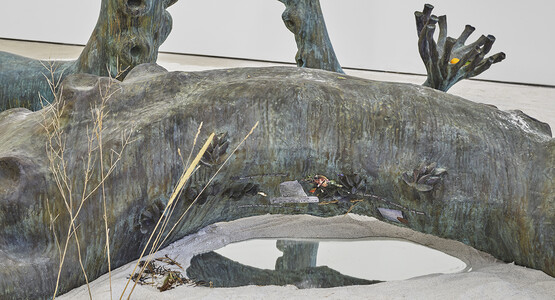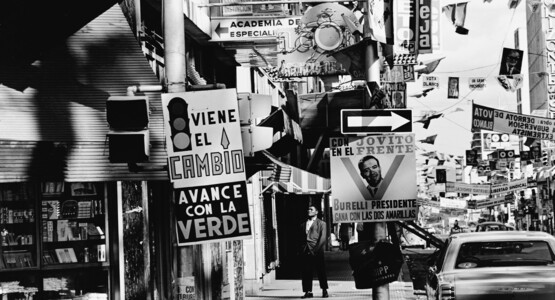Luis Camnitzer’s ‘A to Cosmopolite’: a site of arbitrariness, bifurcation and contemplation
by Ivy Haoying Huang • November 2023 • Journal article
It is a project with so many pages that I won’t live long enough to finish it. My interest in that sense is in conveying the limitations that any system of order has, and the danger of letting that order take the place of reality and therefore impairing rather than helping our acquisition of knowledge. So, it’s more about sharing this idea than about presenting a new finished dictionary.1
Introduction
As reality migrates to a realm of computational abstraction, Google Maps has emerged as a new template of geographic reality, conferring locationality to sites one can ‘visit’ without going anywhere. In his installation A to Cosmopolite (2020–22), the German-born Uruguayan conceptual artist Luis Camnitzer (b.1937) interspersed pages taken from a 1972 copy of Webster’s Unabridged Dictionary with screenshots from Google Maps.2 The locations in the screenshots correspond to the dictionary entries, taking the viewer on a disorienting journey that parallels how people roam through a proliferation of data in our digitised world. Cross-examining two classification systems of information, Camnitzer stages synchronised acts of map-reading and dictionary-making as his ‘cultural portrait’ of today’s power–knowledge landscapes and their ramifications.3
Camnitzer is an artist, educator and writer, who was at the forefront of 1960s Conceptualism. In 1939 his family fled Germany to escape the Nazi regime and settled in Uruguay.4 The artist moved to the United States in 1964 and co-founded the New York Graphic Workshop (1964–70) with the artists Liliana Porter (b.1941) and José Guillermo Castillo (1938–99).5 There he experimented with Mail art and generated new languages of printmaking with liberating potential and political potency. For Camnitzer, art carries as much moral valence as any political event, and as such it is epistemically unjust to dissociate it from larger sociopolitical debates.6 Throughout his career, the artist advocated for what he terms ‘art thinking’. This can be characterised as a process of problematisation facilitated by the viewer’s encounter with an art object, which expands other forms of thinking.7 To meaningfully experience a work of art is not to view it simply as a means of material production, but to critically engage with the work’s potential to ask questions and provide answers.8 According to Camnitzer, this process ‘places the lay viewers on the same level with the artist’,9 allowing room for dialectics and a reverse teaching, in which viewers impart knowledge or introduce order to chaotic ‘dumb art’.10 In a sense, Camnitzer’s works encourage the viewer to embark on a process akin to an ethnographic, art-historical or sociopolitical inquiry, in such a way that the critical thinking process is no longer detachable from the art viewing experience.11
Installed as the centrepiece of Camnitzer’s solo exhibition Arbitrary Order at Alexander Gray Associates, New York (19th January–25th February 2023), A to Cosmopolite FIG. 1 demonstrates the artist’s interest in subverting the dominant power–knowledge regime. As a form of virtual travel during the COVID-19 pandemic, Camnitzer entered tens of thousands of entries from Webster’s Dictionary into Google Maps, taking screenshots of the corresponding locations (if any) ranked first by the site’s algorithm. Over the course of three years, the artist worked on the project at home, realising thousands of spatio-temporal entities from a fixed location.12 Using Photoshop, Camnitzer wove the definition–location pairings, formed from disparate systems with inconvertible compositional, epistemic and presentational standards, into a digital archive of travel testimonies. By strictly adhering to the compositional logic of the dictionary, Camnitzer’s disruption of the system stays anchored to its formal structure. Interweaving cartographic and lexicographic frameworks, A to Cosmopolite presents a transcultural and translinguistic reality that is simultaneously realised and undermined by Google Maps.
A mental, not visual, grid
When working on A to Cosmopolite, Camnitzer could not predict what the Google Maps algorithm would deem the most relevant result related to a given dictionary entry, or indeed, whether there would be one at all. When an entry failed to yield corresponding results, the artist would skip it and move on to the following one. The algorithm’s unpredictability disrupts the dictionary’s page order and typographical logic, allowing the artist to build a ‘new’ dictionary through insertion, repositioning and repagination FIG. 2 FIG. 3. The arbitrary nature of Camnitzer’s work is first and foremost the result of his structural manipulations. In particular, the artist has noted an interest in the construction of image–language matrices:
I needed a general matrix, a grid into which work could be organized and where irrelevant pieces would automatically be excluded. … I found the answer in works from 1967 and 1968, a series of dictionary pages. They belonged to an image-language dictionary, where any image could accept all the meanings attributed by myself or by the public. The newly found matrix allowed me to design a format for the work before dealing with the particular pieces. Once the relation between image and text was laid out, the content of either one became unimportant.13
For Camnitzer, the efficacy of an image–language matrix, or an ‘image-object-word sequence’ as characterised by Mari Carmen Ramírez, is realised by its structure rather than content.14 Decontextualised interpretations of the images or texts – as elements free from their entanglements – would only reduce the image–language matrix to a mere list of items. Akin to a conceptual gestalt, the perception of the structural whole outweighs that of its parts. In fact, as Ramírez contends, when perceived in isolation, the visual, physical or linguistic elements do not ‘function anymore for him: they had to come together in order for the reality or idea to exist’.15
In a conversation with Alexander Alberro in 2014, Camnitzer describes the dictionary as ‘the ultimate matrix’, concluding that what he was fundamentally interested in was ‘a mental grid; not a visual grid, but a concept’.16 The artist has produced many dictionary-inspired works, including Envelope FIG. 4, Dictionary (1969–70) and English Dictionary (1969–71). In fact, Alberro argues that the dictionary itself can serve as a metaphor for Camnitzer’s practice. Just as the dictionary allows the viewer to browse and research through its very structure, Camnitzer’s works activate the viewer’s role as a critical thinker, who engages in meaning-making and problematisation processes.17 It is worth noting that Camnitzer emphasises the conceptual nature of his matrix by stating his preference for a ‘mental grid’ over a visual one. This does not necessarily mean that the artist is unwilling to abide by formal standards; quite the contrary, in his reference to visual rules, Camnitzer invites questions about the very act of following such rules.
For the artist, ‘the arbitrariness of meanings and nomenclature’ is another key facet of the dictionary’s appeal.18 For instance, in Envelope, each of the ten etchings shows two concentric squares connected by diagonal lines. The individual captions are the only perceptible difference: ‘envelope’, ‘tunnel’, ‘painting’, ‘window’, ‘screen’, ‘room’, ‘grid’, ‘box’, ‘cube’ and ‘roof’. This juxtaposition is indicative of the artist’s interest in how meaning is assigned. The image–word pairings debunk the singularity and fixity of meaning, alluding to the possibility of coexisting referents. The image remains unchanged, serving as a conceptual grid with which to foreground the variability of the captions. Considering that the viewer will likely ‘read’ the image before the text, this delay may contribute to speculation regarding the consecutive caption. Thus, a sense of arbitrariness also arises from a ‘definitions-expectations’ structure.19 As Alberro and Ramírez have argued, the slippage between definition and expectation allows viewers to reassign meanings to the information provided, integrating the narrow referential correspondence into broader social and connotative contexts.20 However, although Camnitzer values the certainty of structure, he is also interested in the role of chance, and has stressed the inseparability of order and chaos, noting that ‘it is a question of whether randomness is a subcategory of order, or if order is a subcategory of randomness’.21
In Memorial FIG. 5 FIG. 6 the artist replicated the Montevideo telephone directory and inserted the names of victims of forced disappearances during the Uruguayan Dictatorship (1973–85). Through this act, Camnitzer resurrects those who had been lost through their rebirth as Montevideo residents.22 The phonebook served as a ‘mental grid’ for the artist, containing his intervention within a set of controllable thematic and visual parameters.23 Camnitzer’s entries are indistinguishable from the original ones, and the logic of their placement is unpredictable and undecipherable. Here, the names of those who disappeared at the hands of the dictatorship and their ‘archived’ data create identity–information pairings, scrutinising how the authoritative mode of list-making confers legitimacy to an individual’s existence and identity.24
Camnitzer once used the phrase ‘controlled ambiguity’ to describe his approach of conveying the conditions for an argument without defining the argument itself.25 The meaning of this phrase is twofold: on the one hand, the artist manipulates the viewers into a well-orchestrated connotative field; on the other hand, they are forced into a dialectical relationship with the work of art and encouraged to become active meaning-makers.26 Indeed, the artist prefers the word ‘manipulation’ over ‘composition’, in acknowledgment of his ethical – rather than solely aesthetic – packaging of information.27 Camnitzer disrupts the system either by placing arbitrary referential signs into a set context (as in Envelope), or by disturbing a predetermined order with a random or inexplicable pattern (as in Memorial and A to Cosmopolite). At the same time, he allows for the liberation of meanings by guiding the viewers to generate their own interventions in the structural fixity he creates.
Site of bifurcation: order and cacophony in definition–location pairings
The dictionary entries in A to Cosmopolite exemplify the alphabetical order and homogeneous typographical standards of our lexicographic framework, whereas the screenshots taken from Google Maps represent a cartographic network of digitally represented landscapes. The work, therefore, becomes a site of disorientation, interweaving order and cacophony. The pages that comprise A to Cosmopolite are organised in a tight grid formation, stretching across five gallery walls FIG. 7. Each of the 678 pieces of paper are seamlessly affixed with no frames or visible hanging mechanisms, highlighting their flat, smooth surfaces.
On further inspection, however, the cacophony of A to Cosmopolite emerges. It does so on a microscopic scale, in the interjection of thousands of coloured screenshots into the already densely packed dictionary pages. Even the monochrome dictionary pages themselves exhibit contrast in their grey tones and the text entries are dissimilar in font size and weight. The Google Maps screenshots foreground a familiar variation of colour schemes. On p.670 FIG. 8, for example, bodies of water are represented in blue; railways and main roads in yellow; smaller roads and paths in white; vegetated land in green; and undefined space in light grey. Some place names are shown in the same colour as the surrounding landscape, whereas others are in a dark grey, or – most commonly – in red accompanied by the now-iconic, red location pin.
Here, the red pin both produces order and multiplies chaos. Virtually all of the screenshots contain the symbol, and its redness pervades the otherwise grey-toned installation, which is mounted on white walls. On the one hand, the repetition of the pin reinforces a sense of structural homogeneity. On the other hand, its proliferation, variable quality, size and alignment generates discord. However, as Camnitzer had little intention of aligning all of the red pins along a strict vertical axis, the composition of the red pins on the page happens purely by chance FIG. 9. The number of screenshots also varies from page to page: the red pin appears as many as twenty times on p.65, only twelve times on p.670 and even fewer times on others. The recurring red pins draw the viewer’s attention to chaos and order, unity and fragmentation, while also revealing their interdependency. The resulting sense of disorientation cannot be alleviated by reading the clues embedded in the work: namely, Google Maps screenshots meant for navigation and page numbers that supposedly denote a linear order.
Site of indeterminacy: correspondence or irrelevance, utility or futility?
Despite the prevalence of the red pin in A to Cosmopolite, when it is de-digitised and situated in this sterilised environment it loses its function, which exists solely in virtual space. On the pages the pins appear in different sizes, in contrast to the Google Maps version, which remains the same no matter how the user manipulates it in digital space. When viewed from afar FIG. 10 the pins are inconsequential red dots, which hold little – if any – referential value. In this way, the pin ceased to be a virtual marker and becomes an actual event: a phenomenological encounter. Of course, this process is the inverse of Google Maps, which transforms every location into a clickable and searchable page that one can ‘know’ without visiting in person. This digital template confers locationality to its users, whose off-screen reality is unverifiable within the context of A to Cosmopolite.
Similarly, Google Maps and Webster’s Dictionary oscillate between functional objects and ones stripped of utility. Google Maps focuses on real-time routing and navigation and Webster’s Dictionary focuses on elucidating concepts, but both are tools for navigating epistemic and physical realms. However, as the dictionary pages are here adhered to the gallery walls, they lose their role as a handheld, personal glossary; moreover, they pale in comparison to today’s searchable digital dictionaries. Even if one is stubborn enough to browse the pages, one would surely learn little from the content, which has been torn apart and fragmented by constant interjections. Nor can A to Cosmopolite function as a navigational tool, despite its topographical imagery. As the inserted location screenshots are selected only by their relevance to lexical cues, rather than longitude and latitude, they thread together a network of semantic space rather than a geographical one.
The unifying presentation of A to Cosmopolite obscures what was likely a chaotic and painstaking process as the artist spent hours searching Google Maps for corresponding areas. Similarly, Google Maps emblematises how the photographic age of mapmaking has democratised the cartographic process, while rendering the labour of data contributors invisible and untraceable.28 The project involves labour not only on the part of individual users who submit location data, but also Google engineers who uphold this mapping system, none of whom are credited.
A to Cosmopolite offers too much information for one to meaningfully absorb and utilise. Camnitzer places the map screenshots where one might expect to see the dictionary illustrations, as though the locations could somehow elucidate the corresponding text entries. For instance, the word ‘Airedale’ – defined as ‘a dog of the terrier family, characterized by brown, black, and gray wiry hair’ – is illustrated, as expected, by a standing dog FIG. 11. However, the drawing FIG. 12 lacks any specific reference to the breed’s characteristic wiry hair, nor does it communicate its distinctive coat colours. The juxtaposed screenshot of ‘Airedale Assoc’ does not lend itself to illustrating or explaining the word either. Due to the limitations of black-and-white images, their low resolution and restrictions of space, the original illustrations fall short of elucidating concepts in any nuanced or substantial way. In addition, from a scientific standpoint, even the textual entries may be insufficient in capturing the essence of complex concepts or creatures. Thus, the futility of conveying information haunts the original texts, illustrations and randomly captured machine-generated images.
Unsurprisingly, discrepancies of meaning and mistranslation emerge in A to Cosmopolite as a result of the hegemony of English. With its universalising approach to organising the physical world as data, Google Maps presents a multitude of visions premised on a logic of generalisation and utility.29 The presence of a cartographic authority, however, presupposes a structure with totalising tendencies, and in this case, a linguistic hegemony.30 Despite using Webster’s Dictionary (a quintessential American English dictionary) and inputting English keywords (albeit some with foreign origins), Google Maps occasionally took the artist to locations in non-English speaking countries, including Japan and Saudi Arabia.
The programme’s indifference or inability to detect and translate linguistic nuances while performing searches reflects an inequality in a supposedly two-way process. For instance, whereas the word ‘archiblast’ FIG. 13 is defined in Webster’s Dictionary as ‘1. egg protoplasm; 2. the outer of two layers of an embryo in an early stage of development’, Google Maps locates the Japanese architecture studio アーキブラスト, the name of which joins the ‘archi’ and ‘blast’ into a compound word to signify architecture and enthusiasm.31 Similarly, the Google Maps entry for ‘bing’ (‘a heap; specifically, a heap of grain’) relates to ‘Bing fang laundromat’ FIG. 14 FIG. 15– the ‘bing’ here being a phonetic spelling of a Chinese name. This linguistic disorientation echoes Camnitzer’s ‘inner rather than a geographic exile’, first as a German Jew in Uruguay, speaking German and Spanish, and then as a Uruguayan in the United States speaking English.32 Thinking of language as a way of living and territory – in particular, Latin American art as an act of reterritorialisation through its ‘Spanglish art’ dialect – the hegemony of English in A to Cosmopolite suggests a marginal position.33
Site of contemplation: post-truth reality or fabrication?
A to Cosmopolite’s vision of reality produces unexpected and often amusing pairings. The 1970s dictionary is out-of-date with the semantic transfiguration of words introduced by non-English languages and cultures, as exemplified by the word ‘bier’, defined as a ‘coffin’, which corresponds to a ‘cheese, charcuterie & craft beer shop’ named Astoria Bier and Cheese in New York FIG. 16. Neither can the dictionary confer knowledge regarding pairings of an arbitrary and absurd nature. For instance, the word ‘biggest’, defined as ‘superlative of big’, relates to a place named ‘Biggest Banana’ on Google Maps FIG. 17, while the ‘black market’, defined as ‘illegal dealing in commodities’, corresponds to a woman’s clothing store called White House Black Market, which playfully juxtaposes the symbol of the United States government authority with that of illegitimate trade FIG. 18 FIG. 19.34 Although Camnitzer does not edit or handpick the Google Maps locations, sometimes they are so outlandish that the viewer may wonder if they are fabricated.
In Jean Baudrillard’s essay ‘The evil demon of images’ (1987), he raises the concern that the image appropriates ‘the real’ in its own game to make the image ‘more real’ than ‘the real’.35 He argues that the coincidence of an image anticipating reality foreshadows a dangerous inversion and ultimately the collapse of reality and its image in a world of simulacra. By providing models with which realities ‘can only coincide’, images have already determined subsequent events, so that no new meanings, or arguably, no meanings at all, can be generated.36 With the help of image editing and informational technology, Google Maps transforms every location into a homogenised page: the Metropolitan Museum of Art, New York, and a local corner shop or gas station, for example, are democratised in the programme, becoming equally abstract, searchable sites. Thus, Camnitzer fabricates an uncanny reality mediated through Google Maps and Webster’s Dictionary by photographic manoeuvres of cropping and framing.
It is hard to deny the appeal of absurd, fabricated realities, especially when attention-grabbing materials are directly translatable into monetary value on social media networks. As the uncanny becomes endlessly shareable content in the form of memes and videos, the habit of browsing is so ingrained that one does not typically contemplate the intrinsic meaninglessness of the act itself. By offering a plethora of ‘post-truth’ information, A to Cosmopolite replicates a mode of browsing that is senseless and infinite; it becomes a site for knowledge-making and unmaking.37 Interweaving Webster’s Dictionary with Google Maps, the work alludes to a future in which all possible informational systems are integrated into a virtual unity, and every particpiant becomes a static site of knowledge.
Systematically scrutinising cartographic and lexicographic frameworks and the shared human endeavour of knowledge-making, A to Cosmopolite provokes disorientation. Pairing entities from two disparate systems with inconvertible compositional, epistemic and presentational standards, A to Cosmopolite fabricates an in-between space that allows for free association. It documents the artist’s sporadic virtual movements realised by Google Maps within a grid of controlled arbitrariness. As a site of perception, it interweaves conflicting experiences of unity and fragmentation using the repeated icon of the red pin to spawn and subdue cacophony. As an explosive site of information, it questions the authoritative structure of knowledge-making and representation, with Google now serving as the template for reality, fabrication and the in-between.
Acknowledgments
The author gratefully acknowledges the support of Alexander Gray Associates, New York, in the research and writing of this article, especially Brian Bentley, as well as Branden W. Joseph and her peers for their invaluable comments on earlier drafts and presentations of this article.




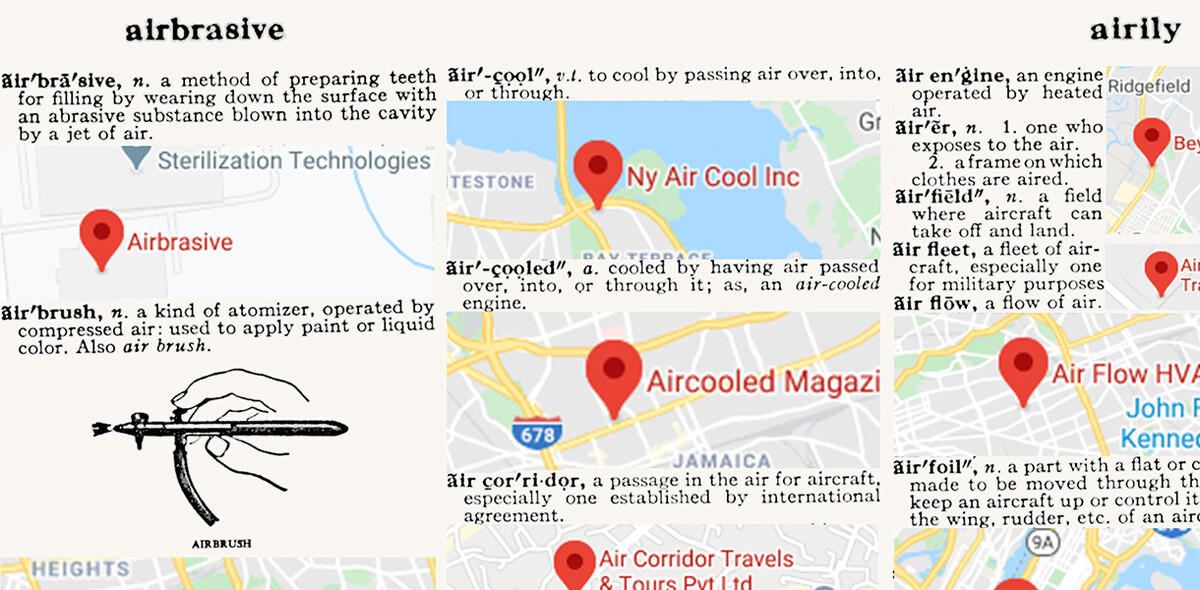

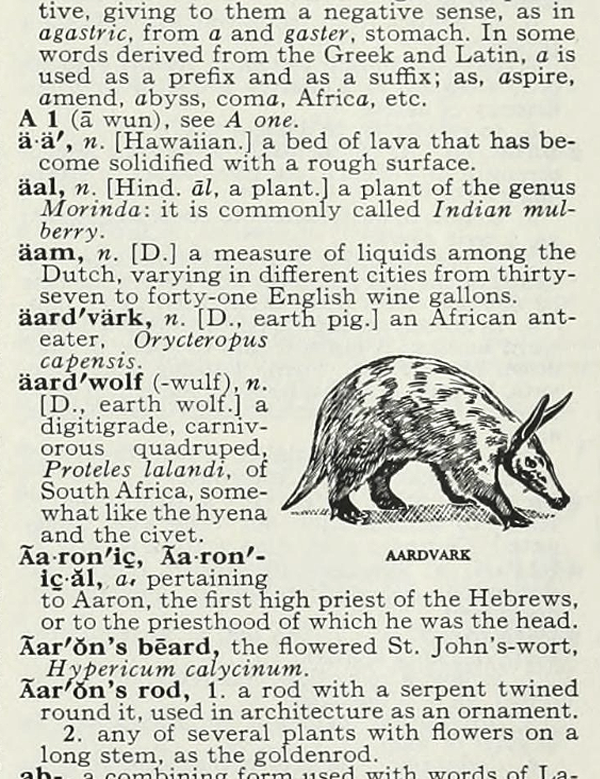
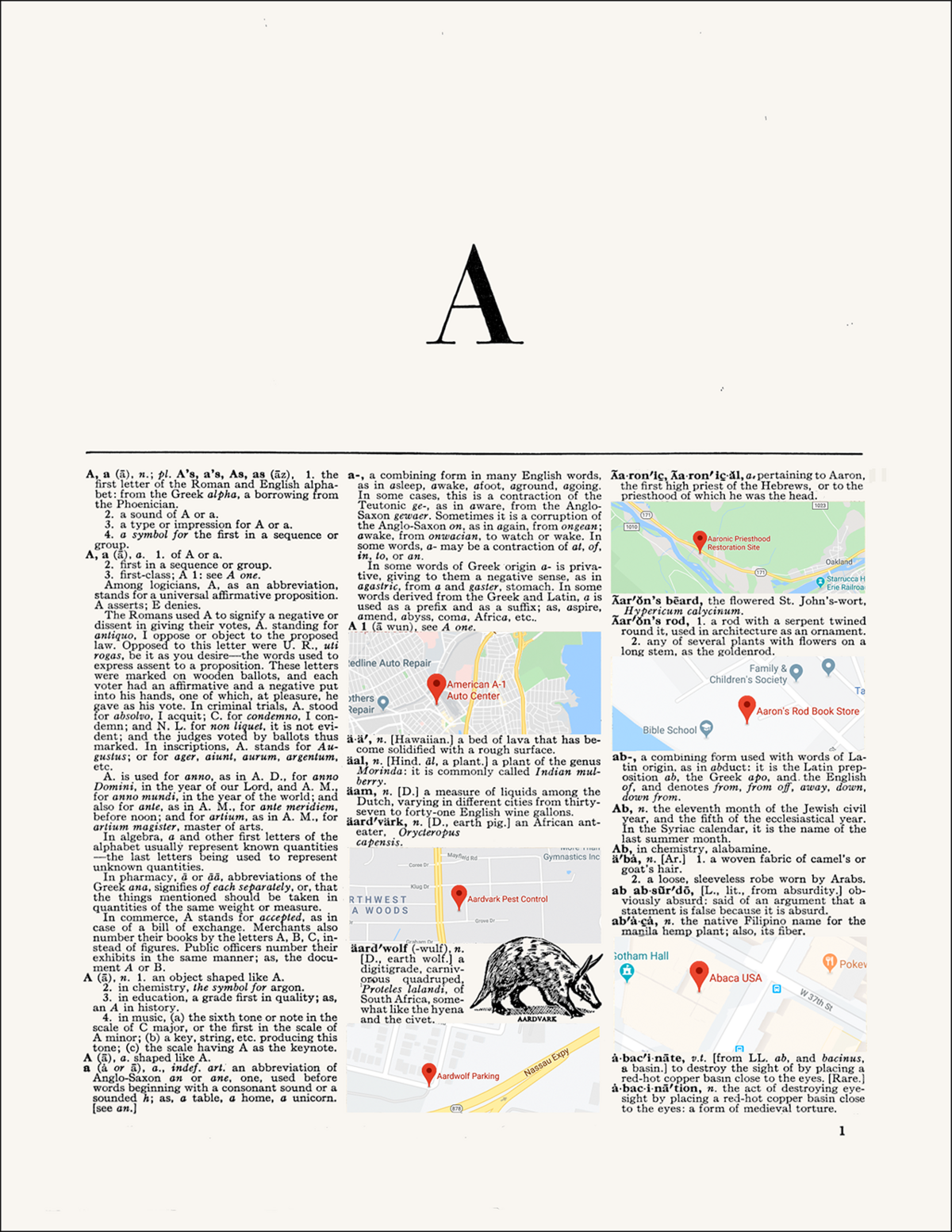
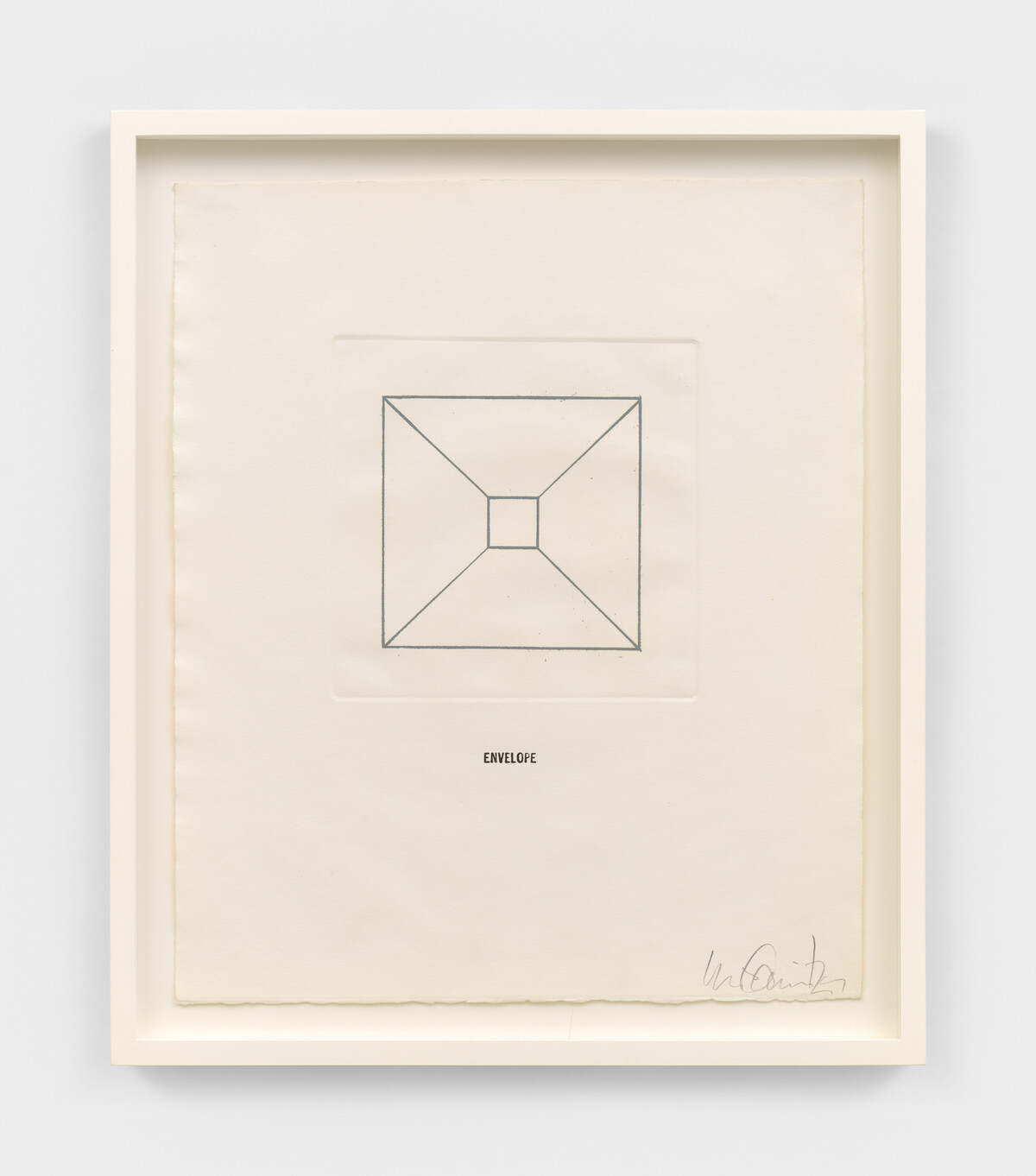
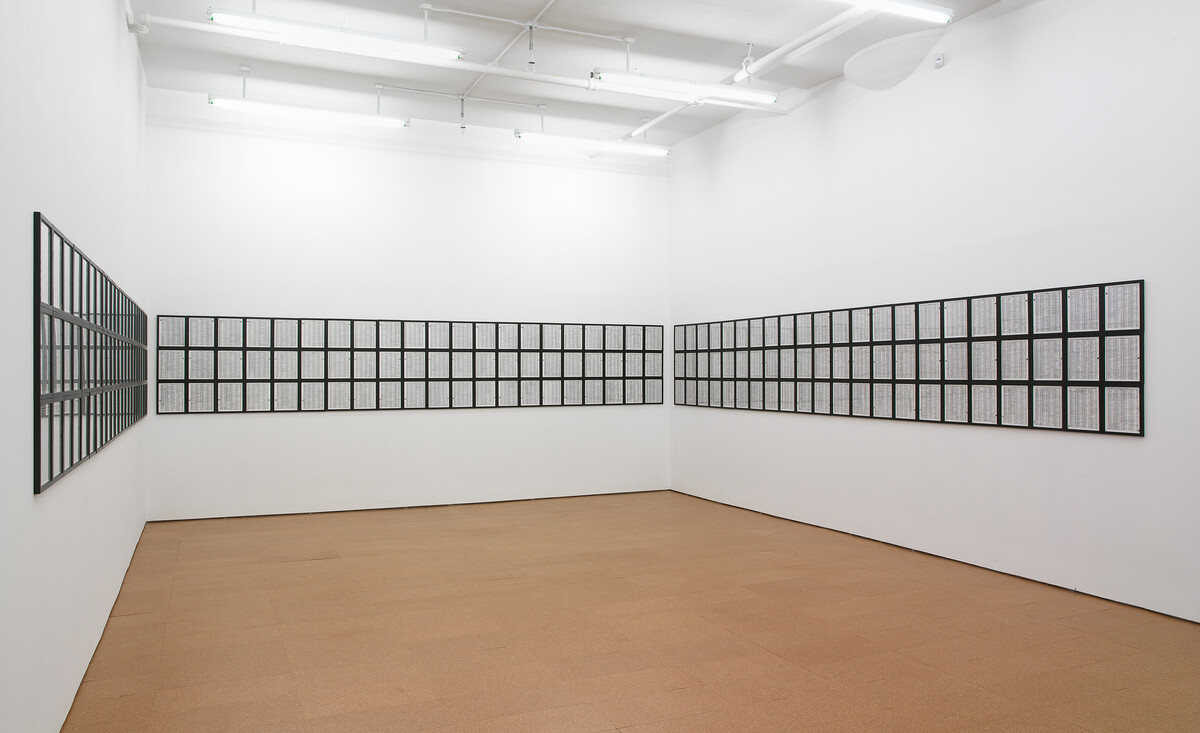
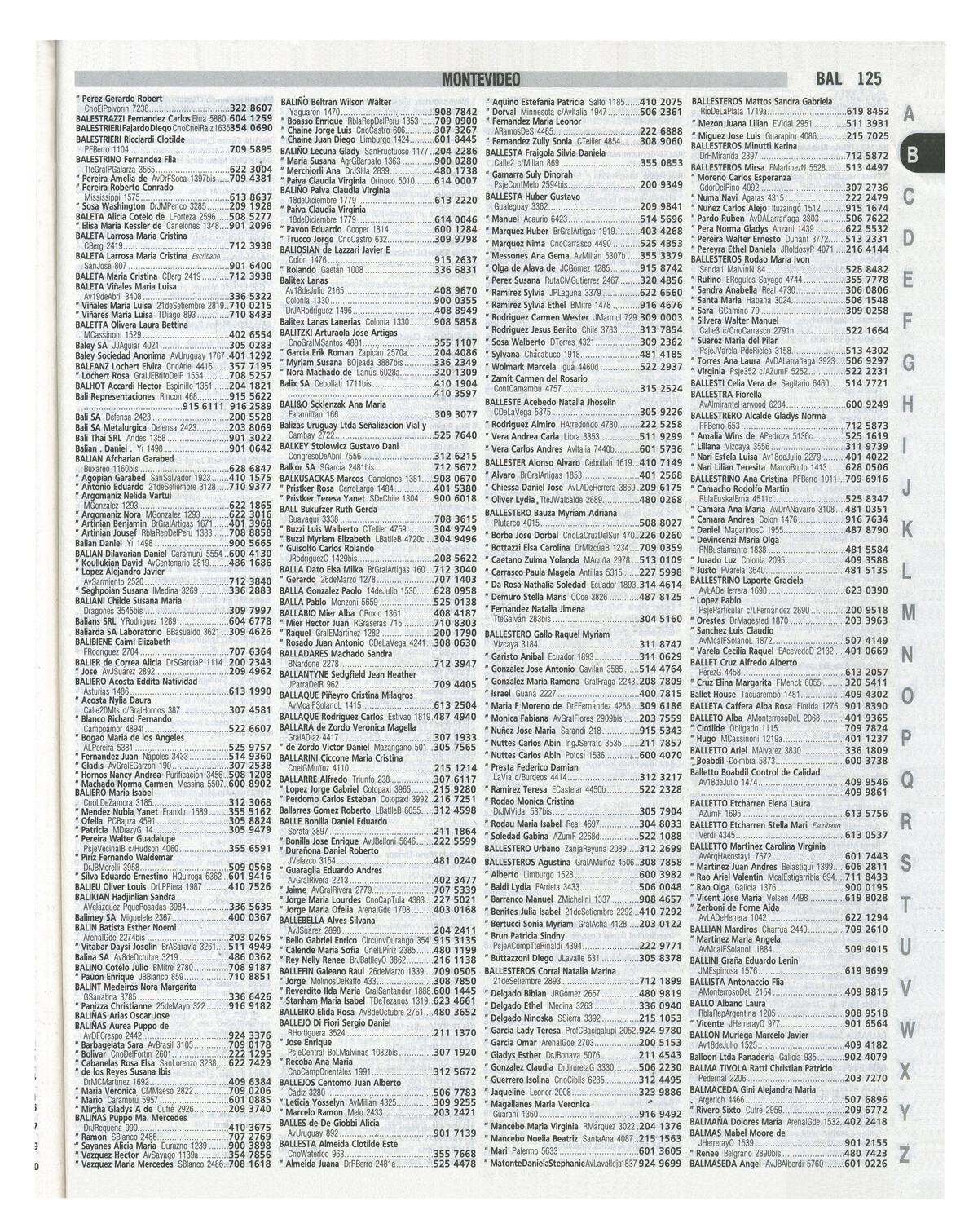
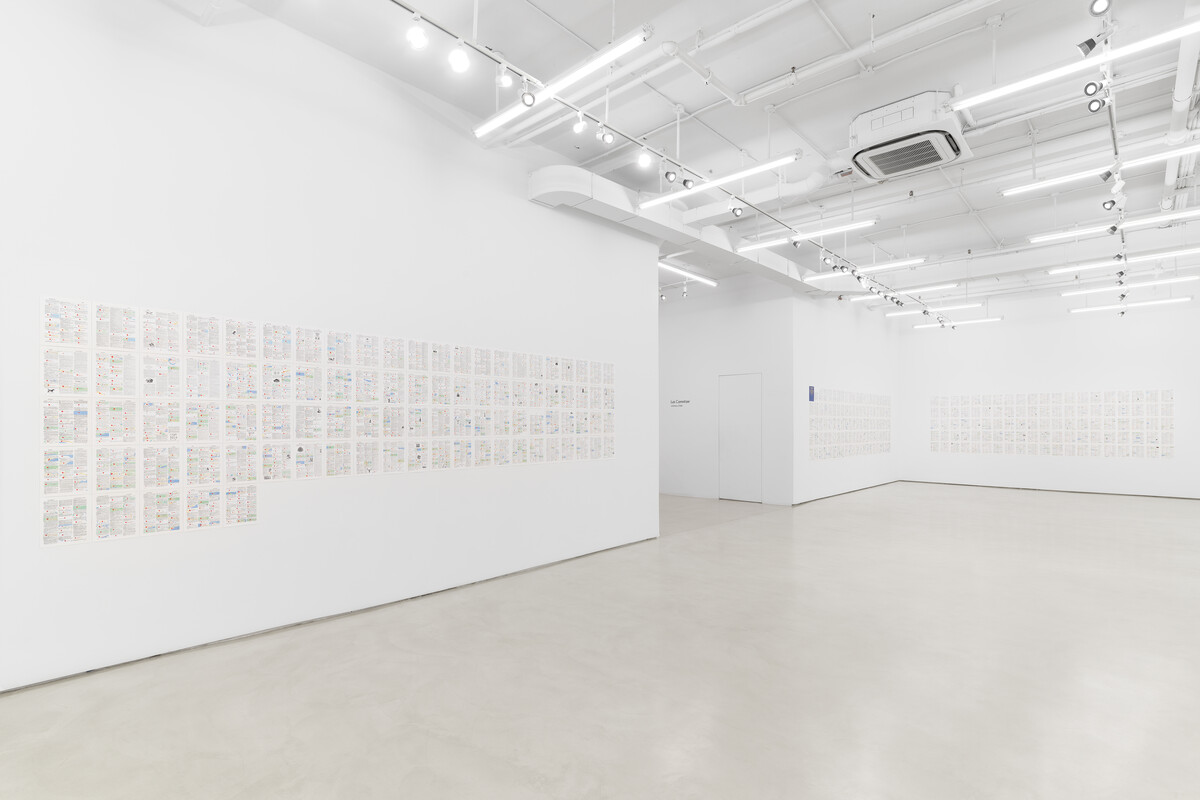

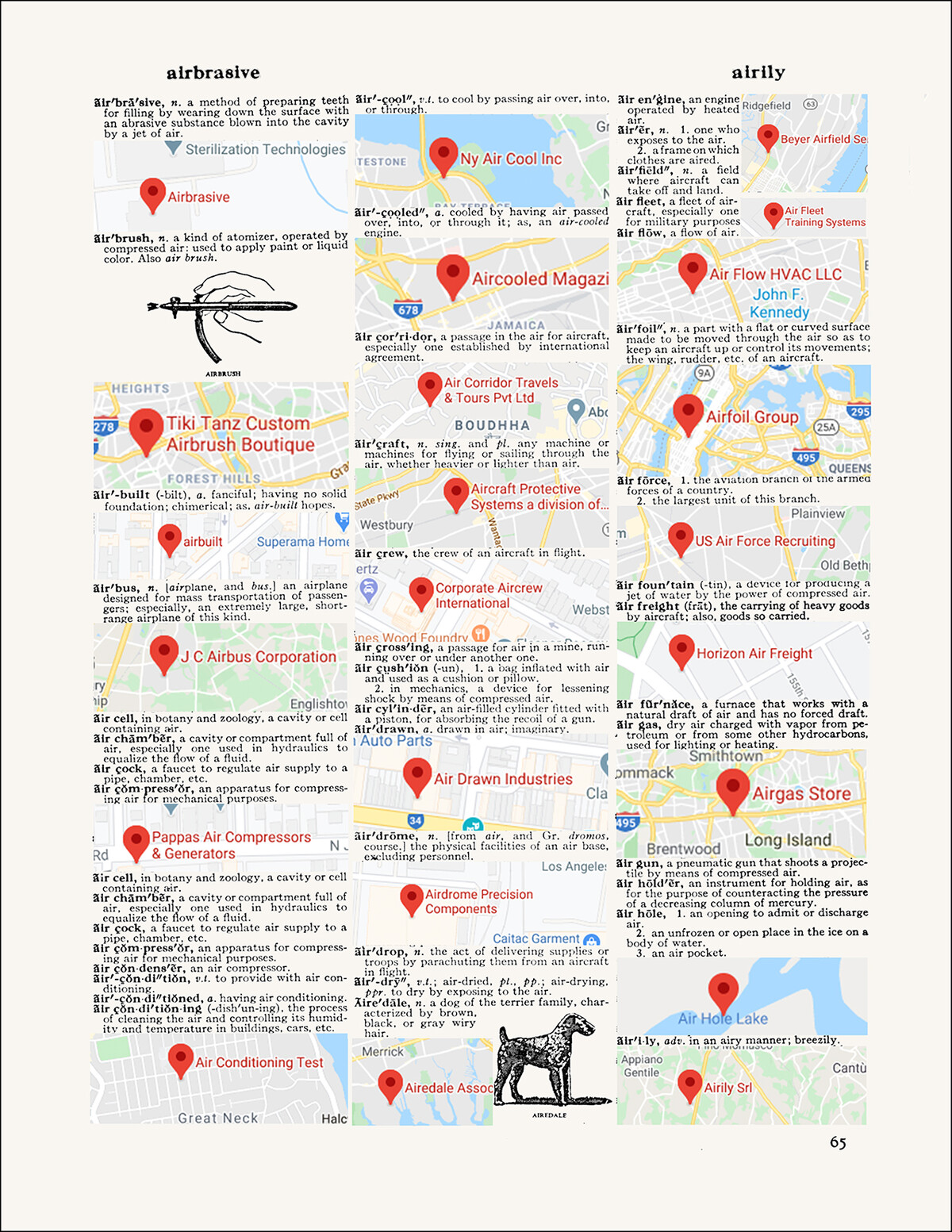
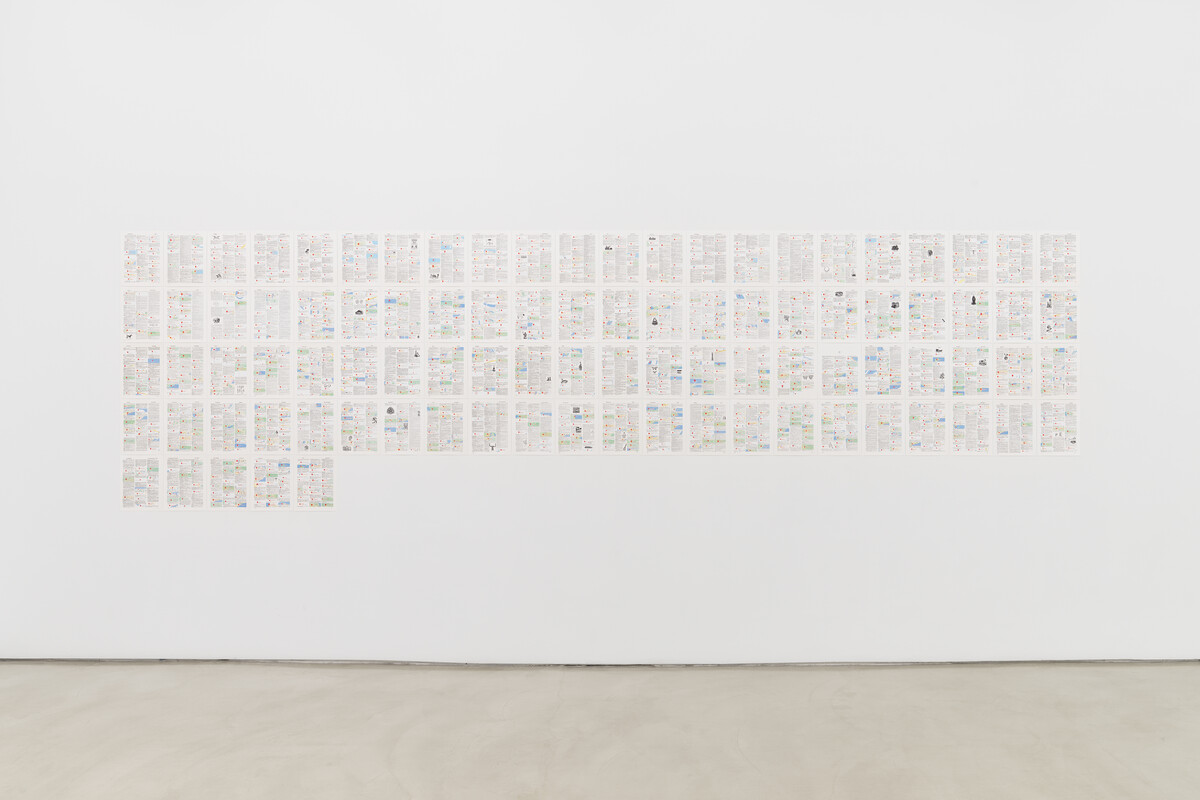
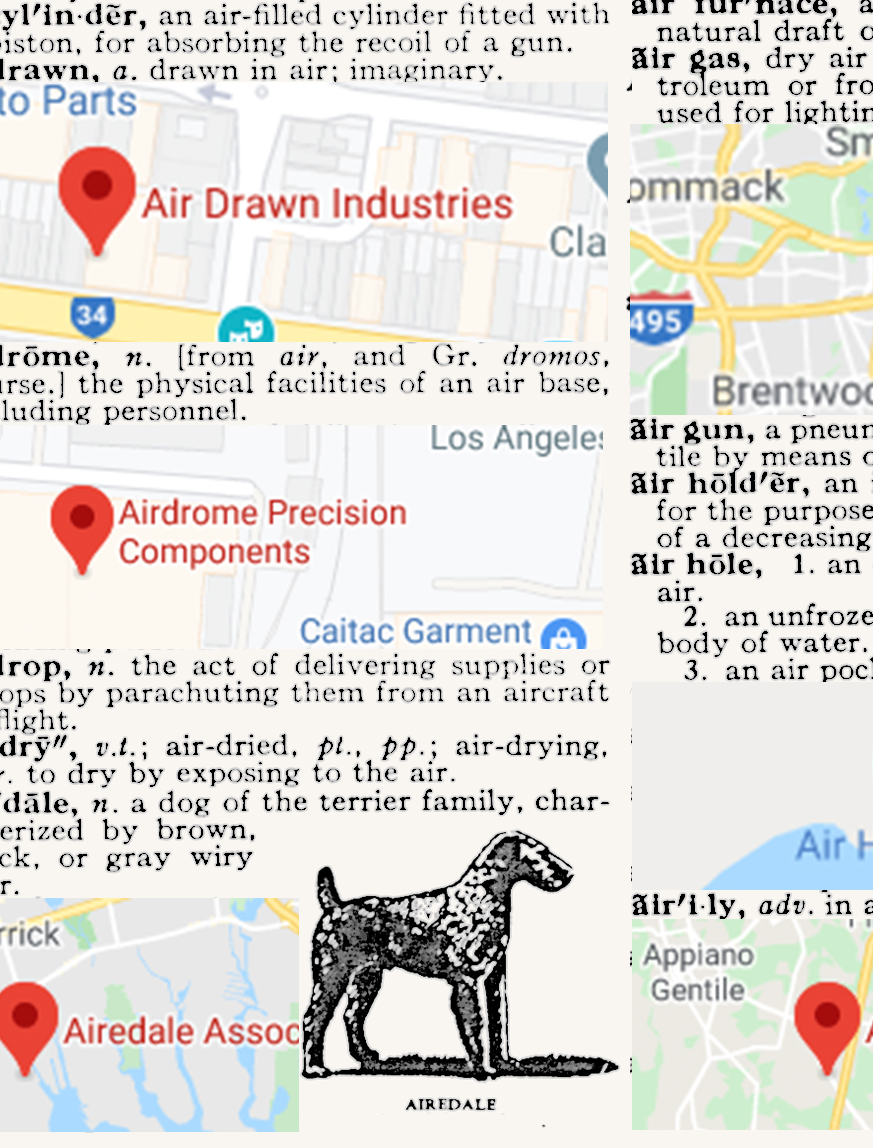
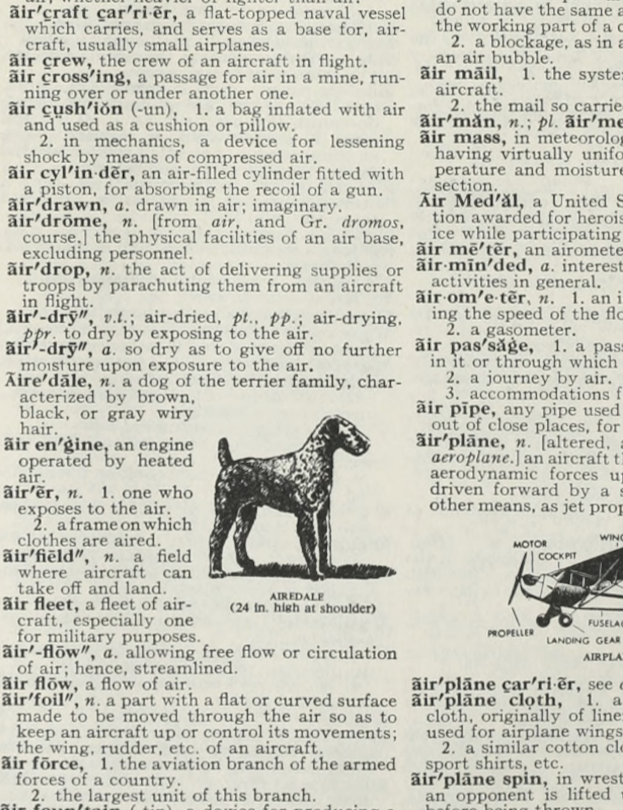
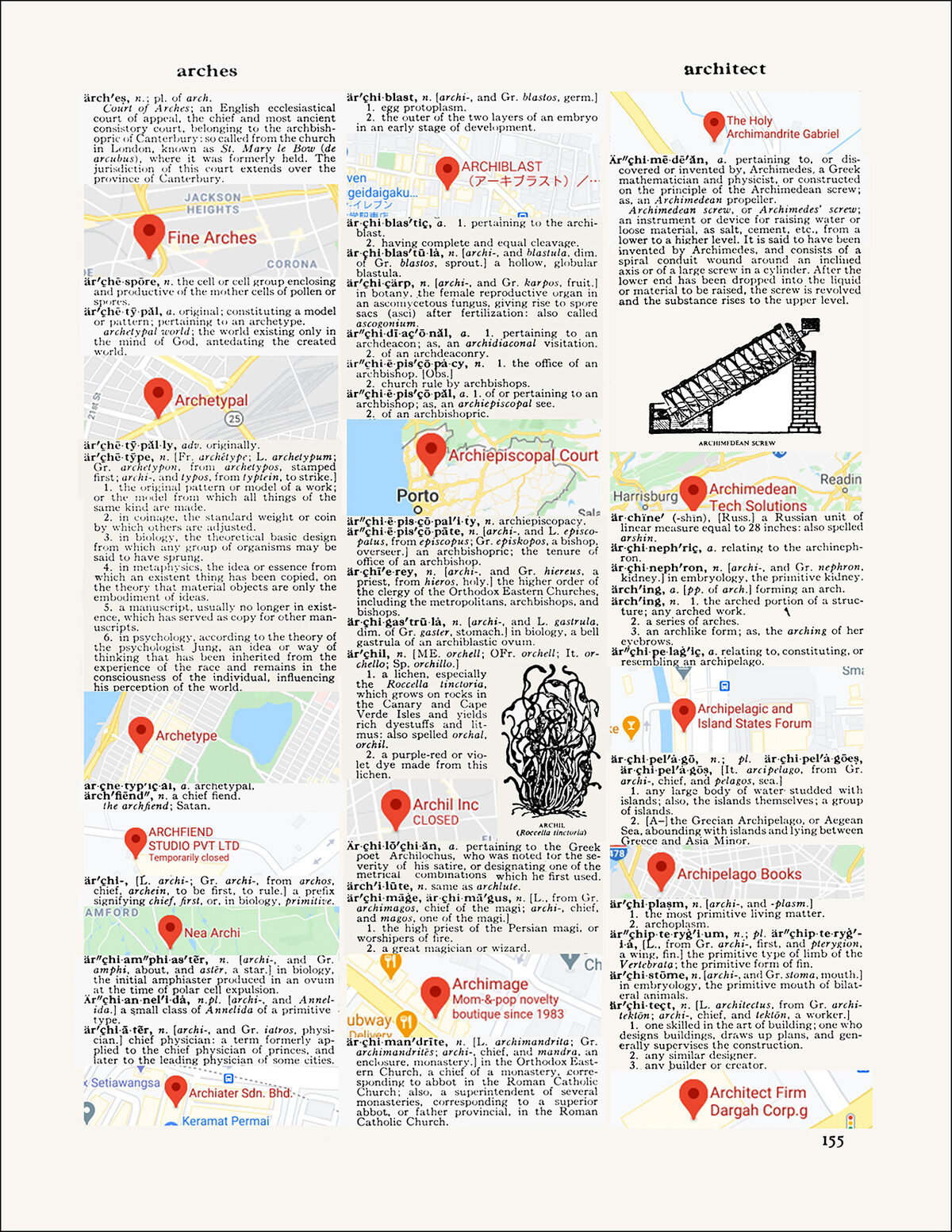
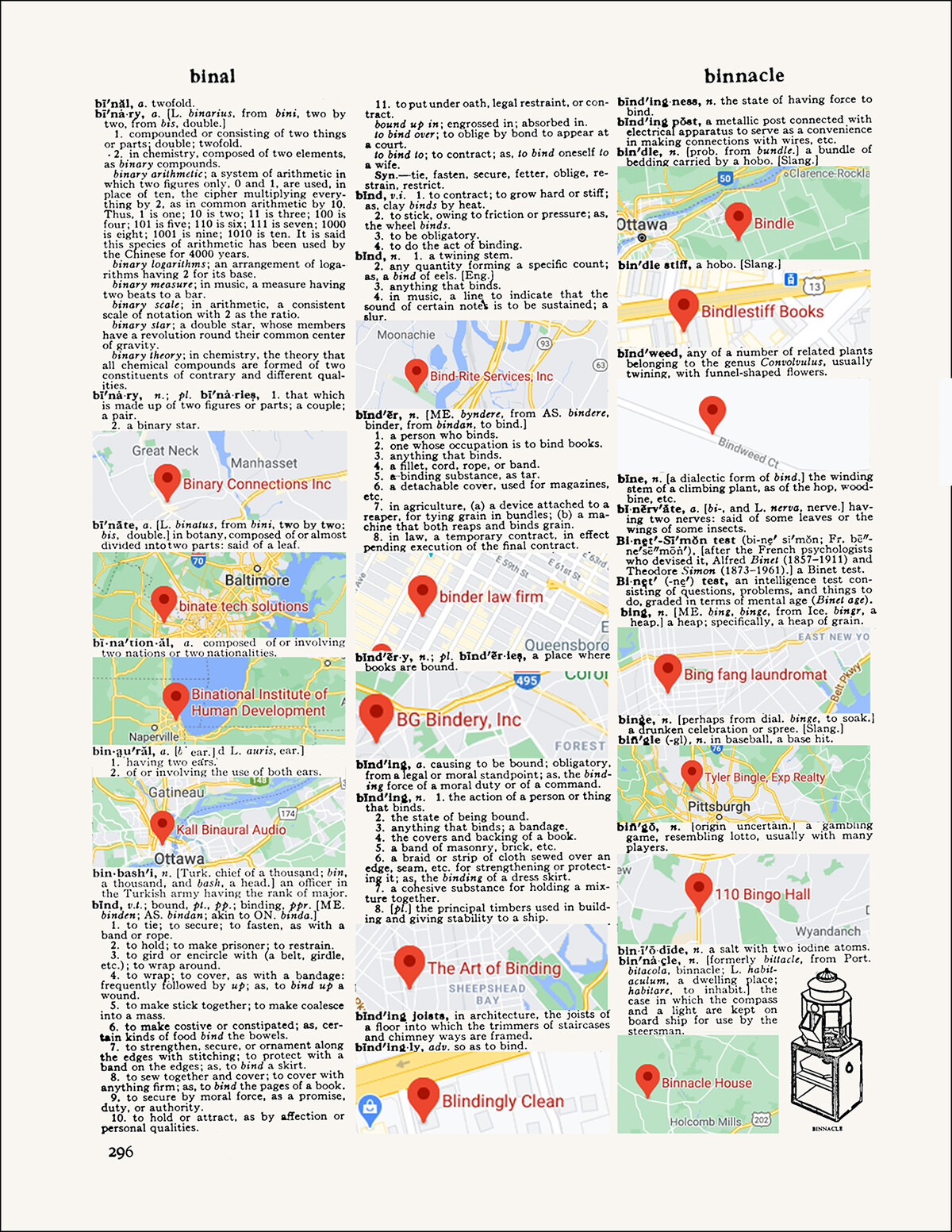

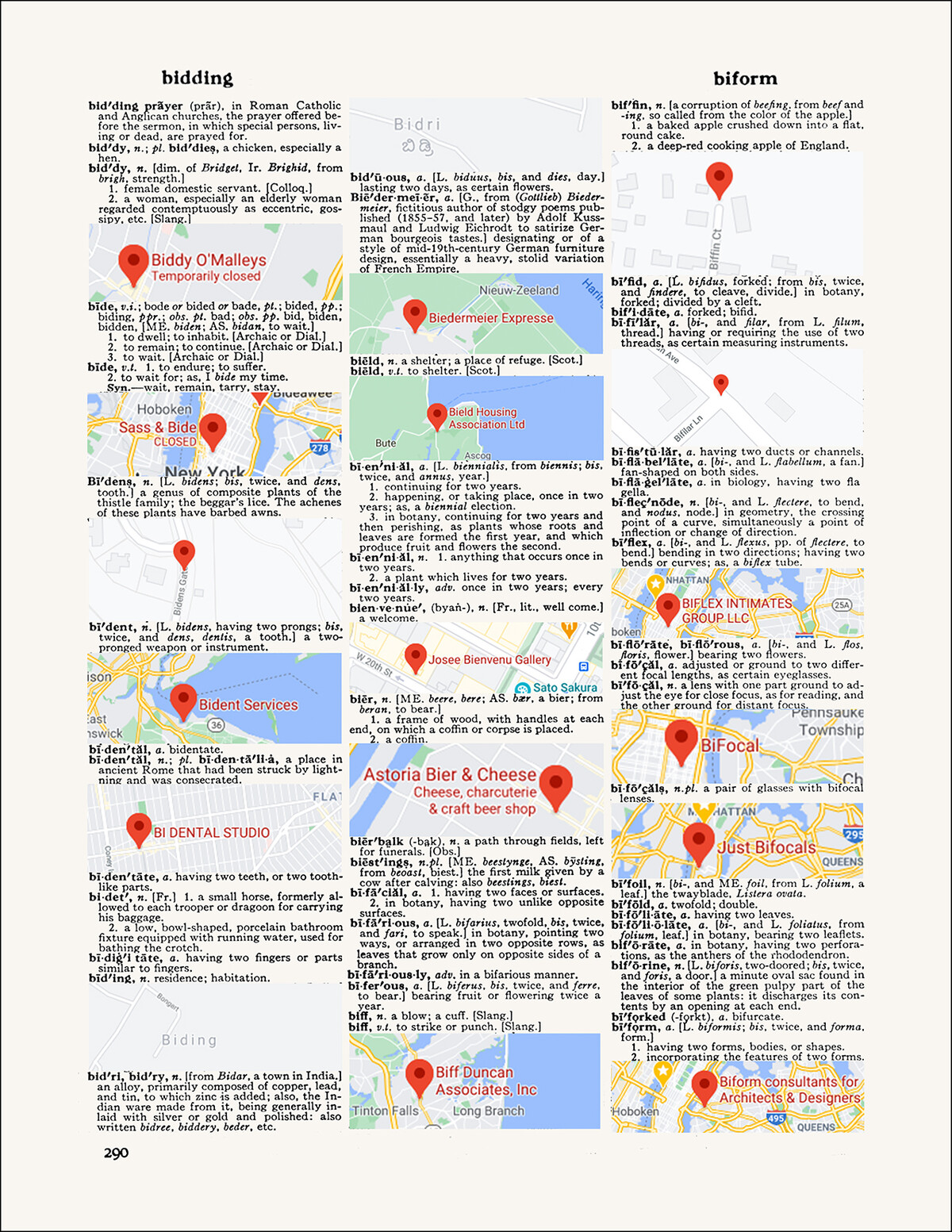
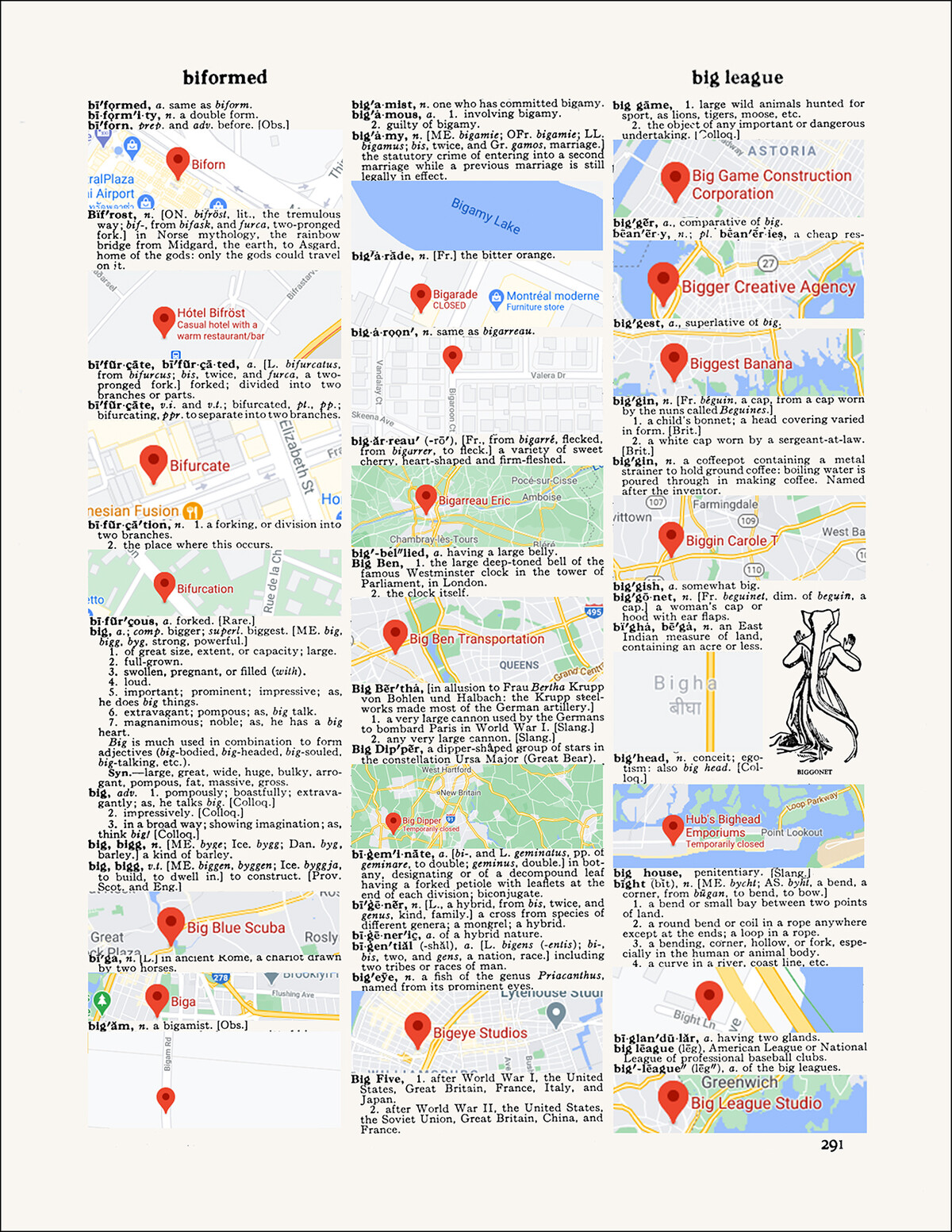
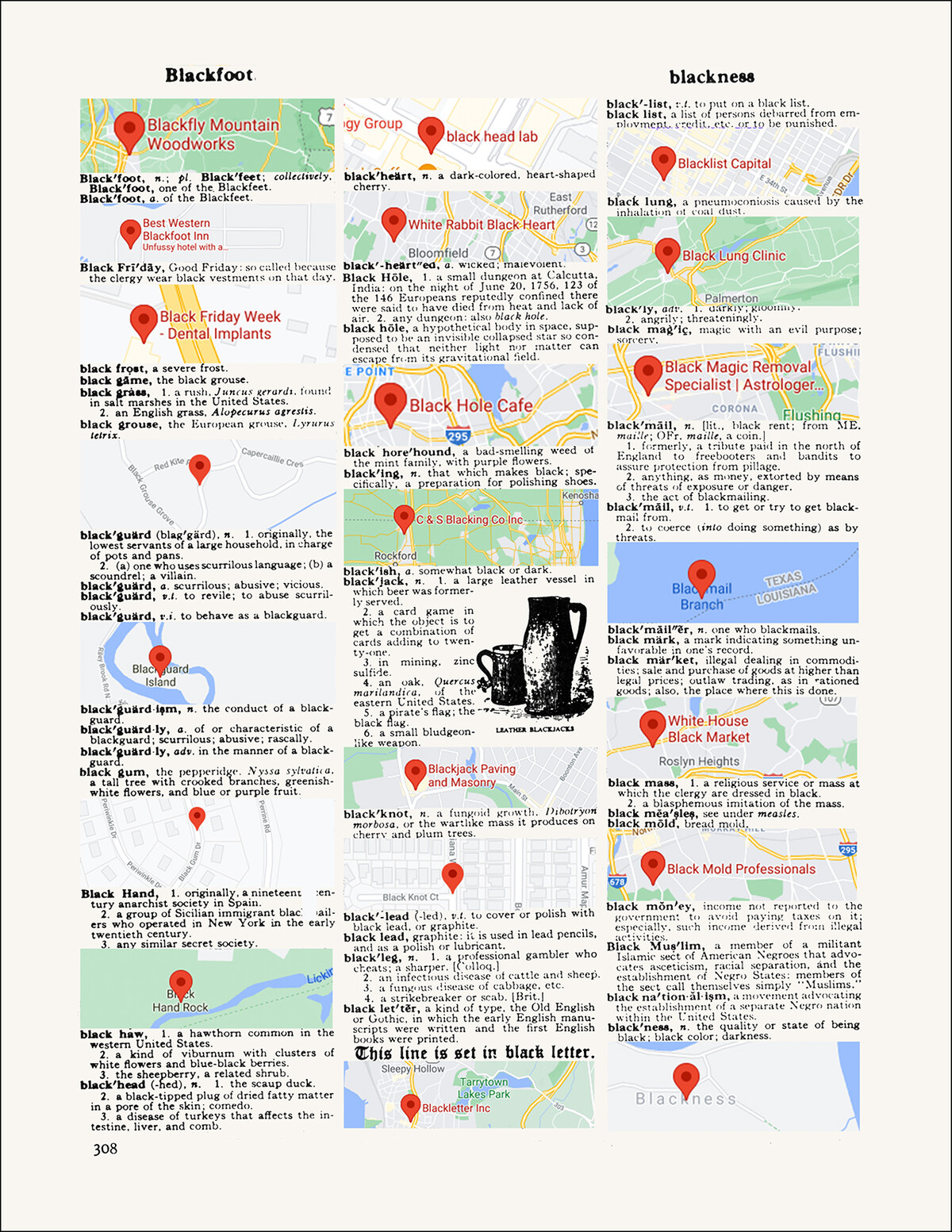
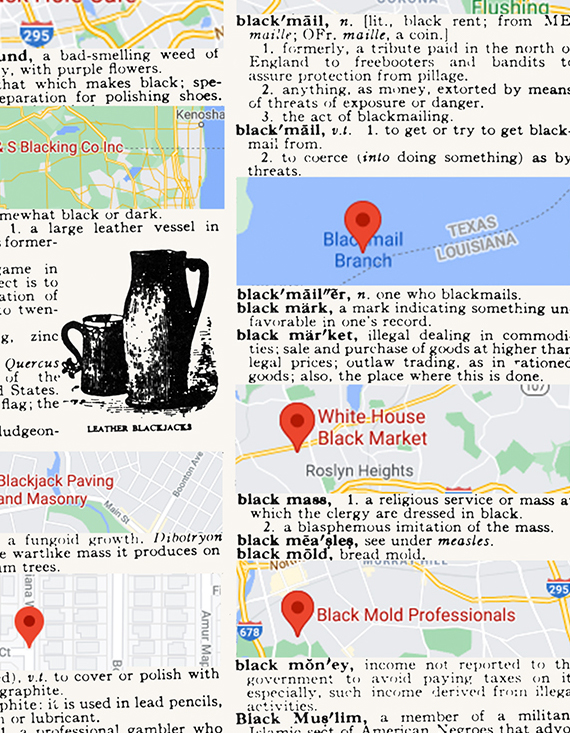

.jpg)
